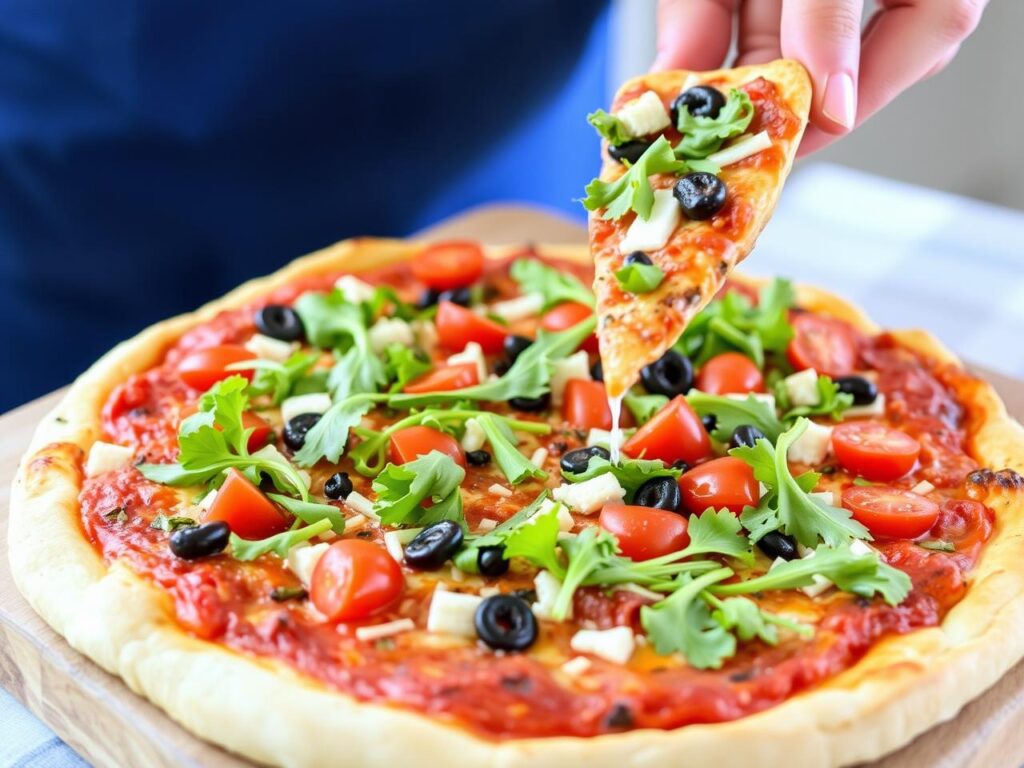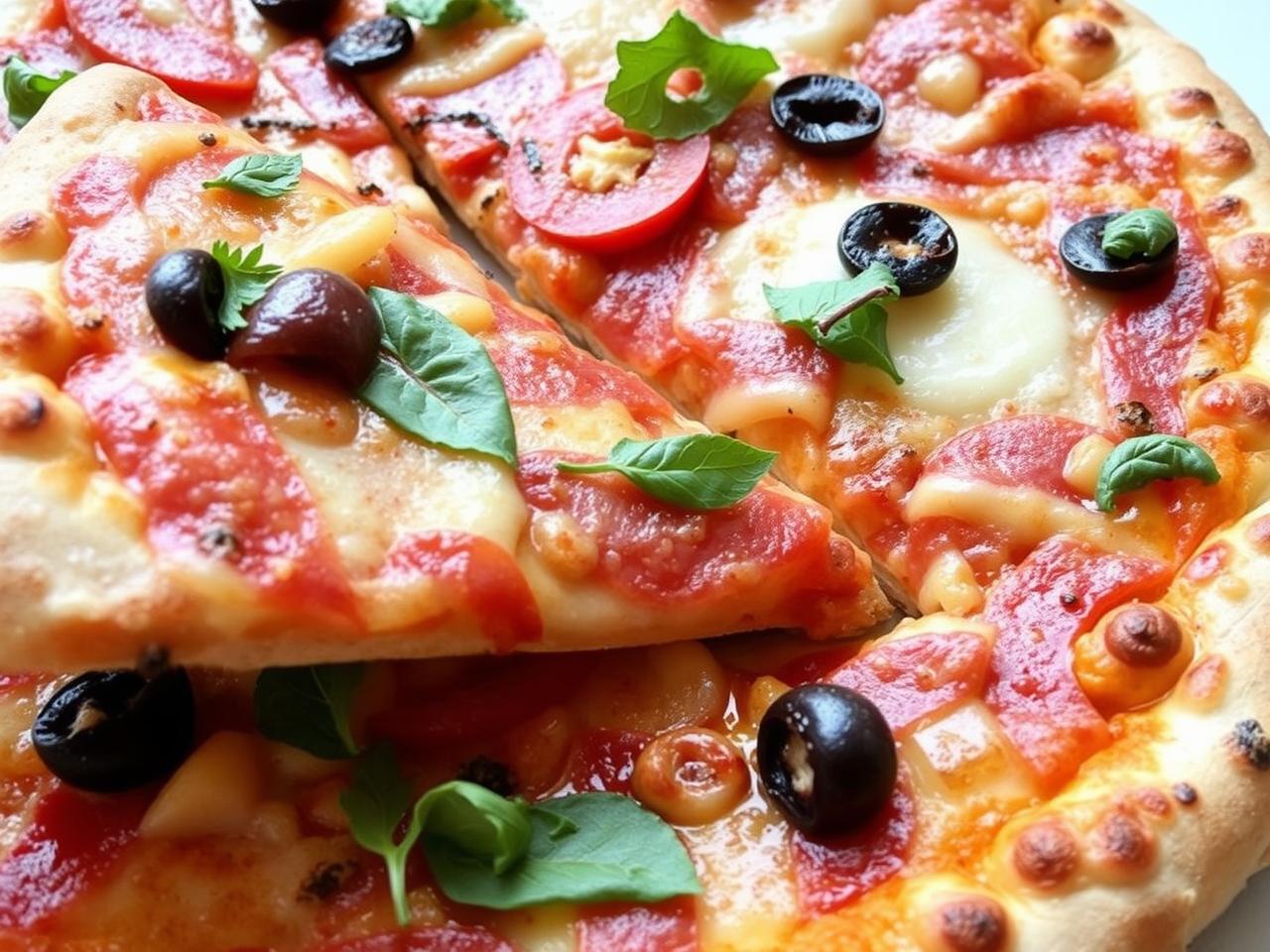How to Eat Healthy… While Still Devouring an Entire Pizza
Portion control is a vital component of maintaining a healthy diet, particularly when consuming pizza. It’s easy to overindulge in pizza, but being mindful of portion sizes helps manage calorie intake and prevent overeating. Strategies for portion control include using smaller plates or cutting pizza into smaller slices, which can create the illusion of eating more.
Paying attention to hunger cues and stopping when satisfied, rather than when the pizza is finished, also aids in portion control. Understanding the calorie content of pizza is crucial for effective portion control. Calorie content varies significantly depending on toppings, crust type, and portion size.
Being aware of these factors allows for informed choices about quantity and toppings. Practicing portion control enables the inclusion of pizza in a balanced diet rather than treating it as an occasional indulgence. By implementing these strategies, individuals can enjoy pizza while maintaining a healthy lifestyle.
Key Takeaways
- Portion control is key to managing calorie intake and maintaining a healthy diet.
- Choose nutrient-dense toppings like vegetables, lean proteins, and healthy fats to boost the nutritional value of your pizza.
- Incorporate a variety of vegetables into your pizza to increase fiber and micronutrient content.
- Opt for healthier crust choices such as whole wheat, cauliflower, or gluten-free options to reduce refined carbohydrates and increase fiber.
- Balance your pizza meal with a side salad to add more vegetables and increase satiety.
- Be mindful of your eating habits by paying attention to hunger and fullness cues, and avoiding distractions while eating.
- Practice moderation and enjoy indulgence by savoring your pizza without overindulging, and balancing it with healthier choices throughout the day.
Choosing Nutrient-Dense Toppings

Veggie Power
Vegetables like spinach, bell peppers, onions, and mushrooms are a great place to start. These toppings add flavor, texture, and a boost of nutrients to your pizza, including essential vitamins, minerals, and fiber.
Lean Protein Options
In addition to vegetables, lean proteins like grilled chicken or turkey sausage can add a satisfying element to your pizza without the excess calories and saturated fat found in traditional meat toppings.
Fresh Herbs for Flavor
Incorporating fresh herbs like basil, oregano, and thyme can also enhance the flavor of your pizza without adding extra calories or sodium. These nutrient-dense toppings not only contribute to the overall healthfulness of your pizza but also add a burst of color and freshness to your meal.
By choosing nutrient-dense toppings, you can create a delicious and satisfying pizza that nourishes your body and supports your overall health.
Incorporating Vegetables into Your Pizza

Incorporating vegetables into your pizza is a great way to boost the nutritional value of your meal while adding flavor and texture. Vegetables not only provide essential vitamins and minerals but also add fiber, which can help you feel fuller for longer and support digestive health. When it comes to incorporating vegetables into your pizza, the options are endless.
You can experiment with a variety of vegetables such as bell peppers, onions, tomatoes, spinach, mushrooms, and artichokes to create a colorful and flavorful pizza. One creative way to incorporate vegetables into your pizza is by making a cauliflower crust or using zucchini or eggplant slices as a base. These alternatives not only add an extra serving of vegetables to your meal but also reduce the calorie and carbohydrate content compared to traditional pizza crusts.
Additionally, using a tomato-based sauce as a topping can add an extra serving of vegetables to your pizza while providing essential nutrients like lycopene and vitamin By incorporating vegetables into your pizza, you can create a delicious and nutritious meal that supports your overall health and well-being.
Making Healthier Crust Choices
When it comes to making healthier choices for your pizza, selecting a healthier crust is an important consideration. Traditional pizza crusts are often made with refined white flour, which lacks essential nutrients and can cause rapid spikes in blood sugar levels. However, there are several healthier crust options available that can help you enjoy pizza in a more balanced way.
Whole wheat crusts, cauliflower crusts, and gluten-free crusts are all great alternatives that provide additional fiber and essential nutrients compared to traditional crusts. Whole wheat crusts are made with whole grain flour, which provides more fiber, vitamins, and minerals compared to refined white flour. This can help support digestive health and provide sustained energy throughout the day.
Cauliflower crusts are another popular option that is lower in carbohydrates and calories compared to traditional crusts. They are made with cauliflower rice, cheese, and eggs, which provides a lighter and more nutrient-dense base for your pizza. Gluten-free crusts are also available for those with gluten sensitivities or celiac disease, providing a safe and delicious option for enjoying pizza.
Balancing Your Pizza Meal with a Side Salad
Balancing your pizza meal with a side salad is a great way to incorporate additional nutrients and fiber into your meal while adding volume and satiety. Including a side salad with your pizza can help fill you up with nutrient-dense foods while reducing the overall calorie content of your meal. Opt for a variety of colorful vegetables like mixed greens, tomatoes, cucumbers, carrots, and bell peppers to create a vibrant and satisfying salad.
Adding a source of lean protein like grilled chicken or chickpeas can also enhance the nutritional value of your salad while adding a satisfying element to your meal. In addition to providing essential nutrients like vitamins, minerals, and fiber, including a side salad with your pizza can also help you practice portion control by filling up on lower-calorie foods before indulging in the pizza. This can help prevent overeating and support weight management while still allowing you to enjoy your favorite foods in moderation.
By balancing your pizza meal with a side salad, you can create a well-rounded and satisfying meal that nourishes your body and supports your overall health.
Being Mindful of Your Eating Habits
The Art of Mindful Eating
Being mindful of your eating habits is an essential aspect of enjoying pizza in a balanced way. Mindful eating involves paying attention to the sensory experience of eating, including the taste, texture, aroma, and appearance of food. When it comes to enjoying pizza mindfully, take the time to savor each bite and appreciate the flavors and ingredients in your meal.
Minimizing Distractions
Avoid distractions like watching TV or scrolling through your phone while eating, as this can lead to mindless overeating and prevent you from fully enjoying your food. Another important aspect of mindful eating is being aware of your hunger and fullness cues. Before reaching for another slice of pizza, take a moment to check in with your body and assess whether you are truly hungry or simply eating out of habit or boredom.
Practicing Self-Awareness
By being mindful of your hunger cues, you can prevent overeating and make more conscious choices about when to stop eating. Additionally, being mindful of your eating habits can help you appreciate the experience of enjoying pizza without guilt or judgment.
Practicing Moderation and Enjoying Indulgence
Practicing moderation is key when it comes to enjoying indulgent foods like pizza. While it’s important to make healthy choices most of the time, it’s also okay to indulge in your favorite foods occasionally. By practicing moderation, you can enjoy pizza as part of a balanced diet without feeling deprived or guilty.
One way to practice moderation is by enjoying smaller portions of pizza or saving indulgent meals for special occasions or social gatherings. This can help you savor the experience of enjoying pizza without overindulging or feeling restricted. Another important aspect of practicing moderation is being aware of the frequency of indulging in pizza.
While it’s okay to enjoy pizza occasionally, it’s important to balance indulgent meals with healthier choices throughout the week. This can help support overall health and prevent excessive calorie intake from indulgent foods. By being mindful of the frequency and portion sizes of indulgent meals like pizza, you can maintain a balanced approach to eating while still enjoying your favorite foods.
In conclusion, enjoying pizza in a balanced way involves understanding portion control, choosing nutrient-dense toppings, incorporating vegetables into your pizza, making healthier crust choices, balancing your meal with a side salad, being mindful of your eating habits, and practicing moderation while still enjoying indulgence. By being mindful of these aspects and making conscious choices about how you enjoy pizza, you can create a healthy relationship with food while still savoring the flavors and experience of indulgent meals like pizza. With these strategies in mind, you can enjoy pizza as part of a balanced diet that supports your overall health and well-being.
FAQs
What are some tips for eating healthy while still enjoying pizza?
Some tips for eating healthy while still enjoying pizza include choosing a thin crust, loading up on veggies as toppings, opting for lean protein toppings, and being mindful of portion sizes.
How can I make my pizza healthier?
You can make your pizza healthier by choosing whole wheat or cauliflower crust, using low-fat cheese, adding plenty of vegetables, and opting for lean protein toppings such as grilled chicken or turkey sausage.
Is it okay to indulge in a whole pizza occasionally?
Indulging in a whole pizza occasionally is okay as part of a balanced diet. It’s important to be mindful of portion sizes and to balance it out with healthier choices throughout the week.
What are some healthier alternatives to traditional pizza?
Some healthier alternatives to traditional pizza include using a portobello mushroom cap as the crust, making a pizza with a whole wheat pita or tortilla, or creating a pizza using a cauliflower crust.
How can I balance indulging in pizza with maintaining a healthy diet?
You can balance indulging in pizza with maintaining a healthy diet by being mindful of portion sizes, choosing healthier crust and topping options, and incorporating plenty of fruits, vegetables, and lean proteins into your overall diet.







